Female leaders still rare at Georgia’s Fortune 500 companies

Georgia’s largest publicly traded companies have increased the number of women at their highest ranks over the past decade, but progress has been slow and most are far from achieving gender parity.
Board directors and particularly top executives remain overwhelmingly male, despite years of employers saying they prioritize diversity and growing pressure from elected officials and investors to elevate more women, according to an analysis of local Fortune 500 companies.
The average board of directors at the biggest Georgia companies was about 27% female at the end of fiscal 2020, up from 14% a decade earlier, according to numbers crunched for The Atlanta Journal-Constitution by Equilar, a corporate governance research firm.
That’s also slightly higher than the 23.5% average that Equilar tracked across companies in the Russell 3000 Value Index, which includes most publicly traded companies on American stock exchanges.
But only a handful of Georgia’s Fortune 500 companies had boards that were at least one-third female at the close of 2020. The Fortune 500 list, made up of the largest publicly traded U.S. companies, included 17 based in Georgia last year. (See note about methodology.)
An even larger gap persists at the senior management level. On average, named executive officers — the chief executive officer, chief financial officer and next three or four highest-paid executives as disclosed by companies in their annual proxy statements — were just 12% female at the Georgia companies.
That figure is more than double what it was a decade ago, but represents only one in eight top leaders.
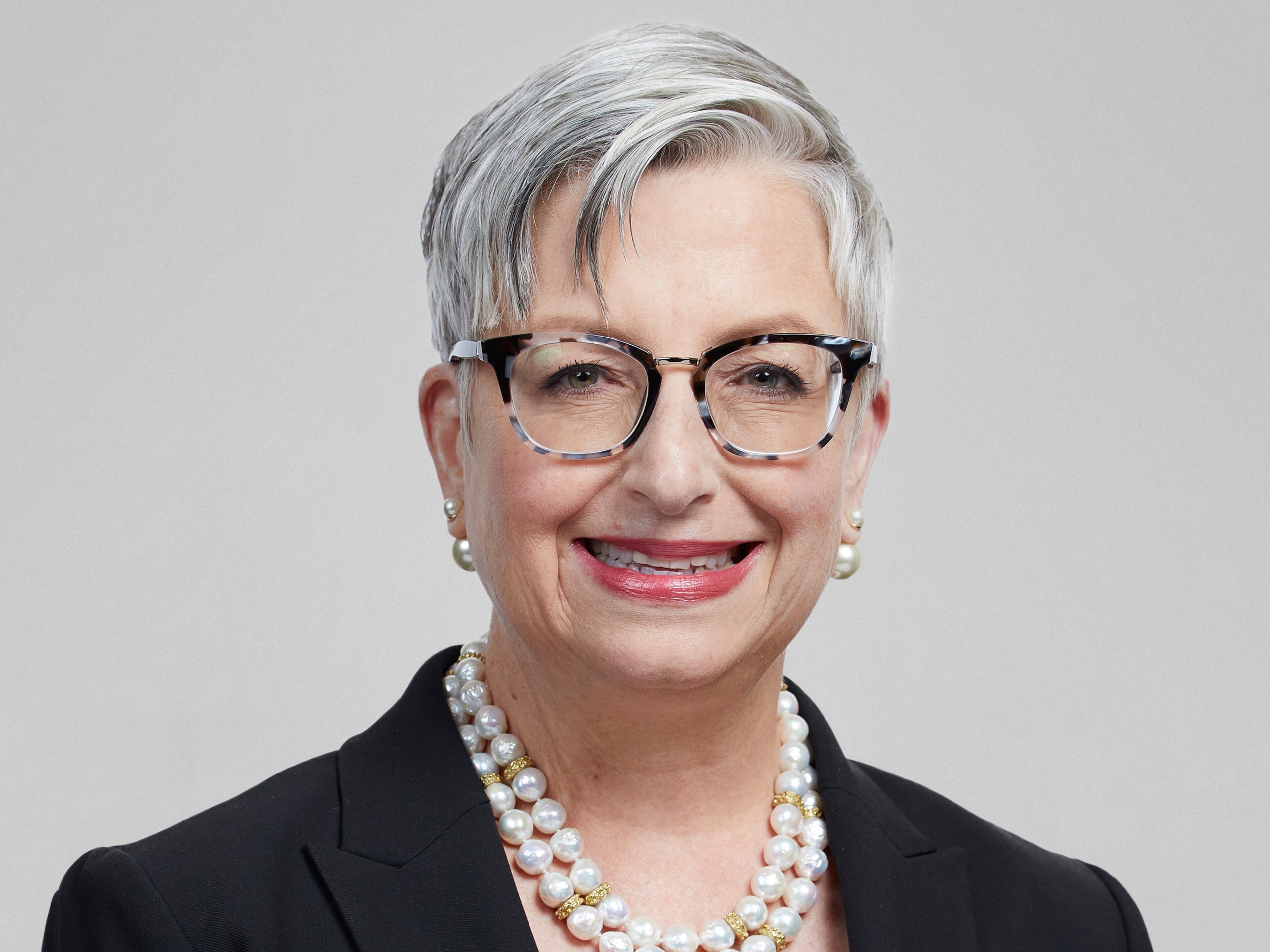
It gets even lonelier at the very top. The only current female CEO among Georgia’s Fortune 500 companies is Carol Tomé, hired by UPS last year. Mary Laschinger retired as Veritiv’s CEO last September.
And while six of the companies employed more female named executive officers than a decade ago, eight — including Delta Air Lines, Coca-Cola and Southern Co. — reported no women in those positions at the end of last year.
For some Georgia women, breaking the glass ceiling has at times required them to put up some plexiglass, as Teresa L. White, president of Aflac U.S., described it in a recent interview.
White was devastated early in her career when some of her employees said she was “unlikeable.” She worked hard to change perceptions, but also learned where to set boundaries.
“A big part of my journey,” she said, “is about me letting go some of the negative thinking or what I heard from other people that distract you from being the best you that you can be.”
Almost all of the 17 Fortune 500 companies said hiring women for senior roles was a major priority. Some highlighted women at the vice presidential level or higher who are being groomed to take over top executive slots or are already running divisions within their organizations. Others have implemented ambitious diversity targets — Coca-Cola, for example, recently reaffirmed its goal that half of its leaders will be women by 2030.
Despite that, groups that track female representation in the workplace say most companies could be doing much more. Nationally, just 8% of Fortune 500 CEOs are women, and only two are Black women.
“What we’re finding is that good intentions aren’t enough,” said Jewelle Bickford, co-chair of Paradigm for Parity, a group focused on closing the gender gap in corporate America.
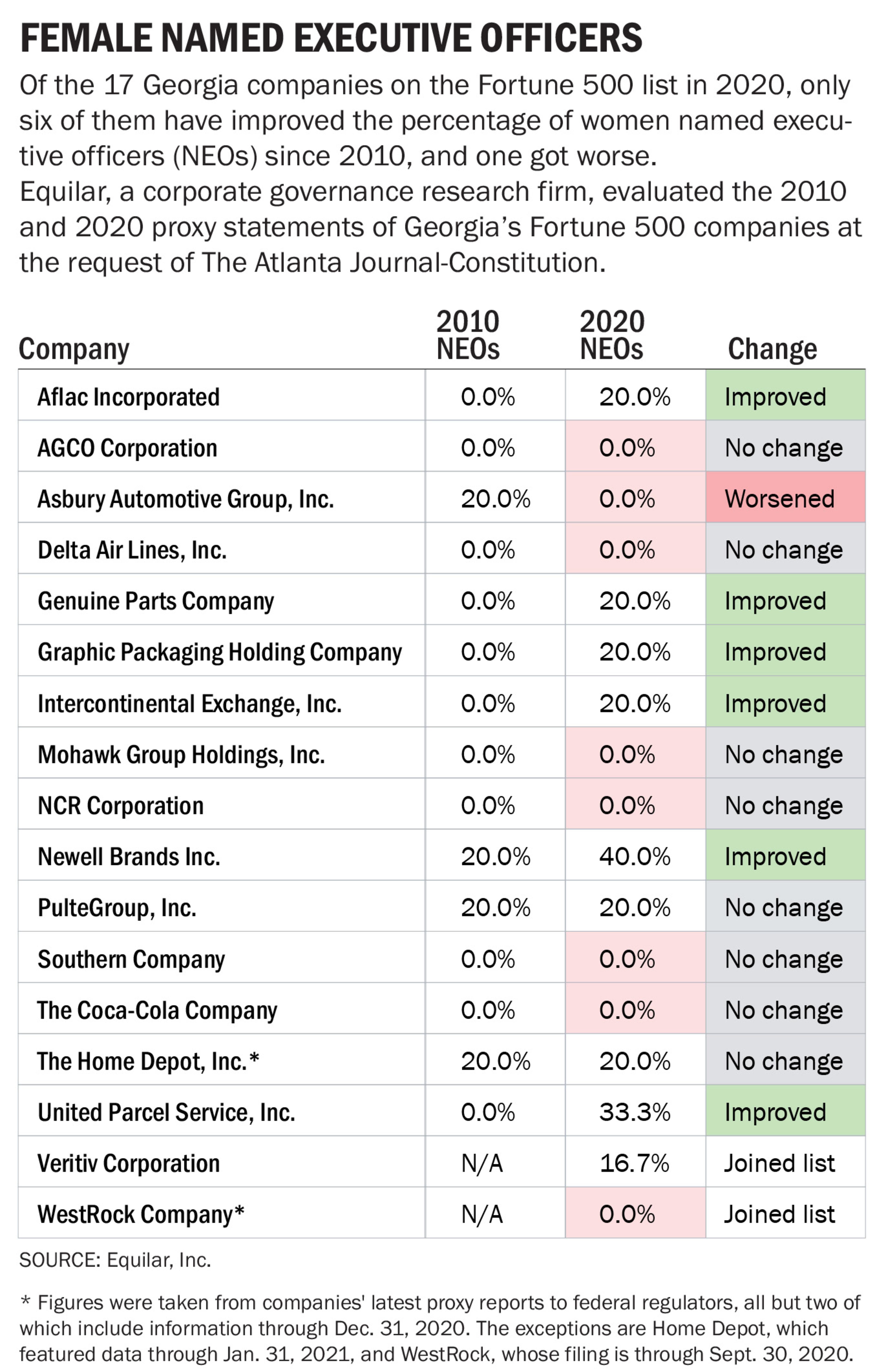
The pandemic also has thrown into question whether recent workplace gains will be here to stay.
A May report from McKinsey and LeanIn.org included a particularly grim statistic: One in four working women was considering downshifting her career or leaving the workforce entirely due to pressures from COVID-19.
“This is an emergency for corporate America,” the report stated. “Companies risk losing women in leadership— and future women leaders — and unwinding years of painstaking progress toward gender diversity.”
Barriers remain
Advocates have long pointed to the economic benefits of gender parity. Studies show links between diverse leadership teams and strong financial performance.
And many companies very publicly support it. Some of the state’s biggest corporations sponsored a women’s empowerment luncheon at a Buckhead hotel this spring organized by the company Little Pink Book.
Speakers at the pink-smattered networking event, including Tomé, White and others, traded stories about barriers they faced and shared tips about how other women could rise in the ranks and lift each other up, including how to find advocates, become indispensable to top bosses and prevent burnout.
But speakers also took care not to criticize their bosses or specific company policies, highlighting the tension for workers trying to make change from within.
OnBoard, an Atlanta-based nonprofit, has worked from the outside to encourage companies to appoint at least three women to their boards, which are mainly made up of directors from outside the company to oversee management. Three is the minimum number needed to begin changing the culture of a company, according to Lisa Robinson, the group’s president.
“It’s hard to just stand up and be the only one in the room, so that power of three is very meaningful,” said Robinson, whose organization helps train women for the board interview process and connects companies with qualified women.
By that metric, nearly two-thirds of Georgia Fortune 500 companies have succeeded. Eleven of the 17 had at least three women serving on their boards at the end of 2020, whereas only one, Coca-Cola, did in 2010.

Companies have been able to shift the makeup of their boards more quickly because seats rotate and appointees can serve on multiple boards at a time.
But it’s taken longer for companies to elevate top female executives responsible for actually running the business — and diversity advocates point to many reasons.
Managers tend to promote people who remind them of themselves. Traditional workplaces often provide less flexibility for mothers, to whom child care responsibilities disproportionately fall. Women of color in particular are more likely to report that they don’t feel heard or have opportunities to advance at work, which can lead to attrition.
Studies show that gender imbalances begin to emerge on the lower rungs of the corporate ladder. For every 100 men promoted to manager, only 85 women were promoted, according to a 2020 McKinsey report, a gap that was even larger for Black women and Latinas.
For the women who do make it to the C-suite, with “chief” in the job title, some get siloed into roles such as human resources or marketing. Those roles are critical for companies, but they don’t oversee profit and loss portfolios, which are a more common pathway to running a company.
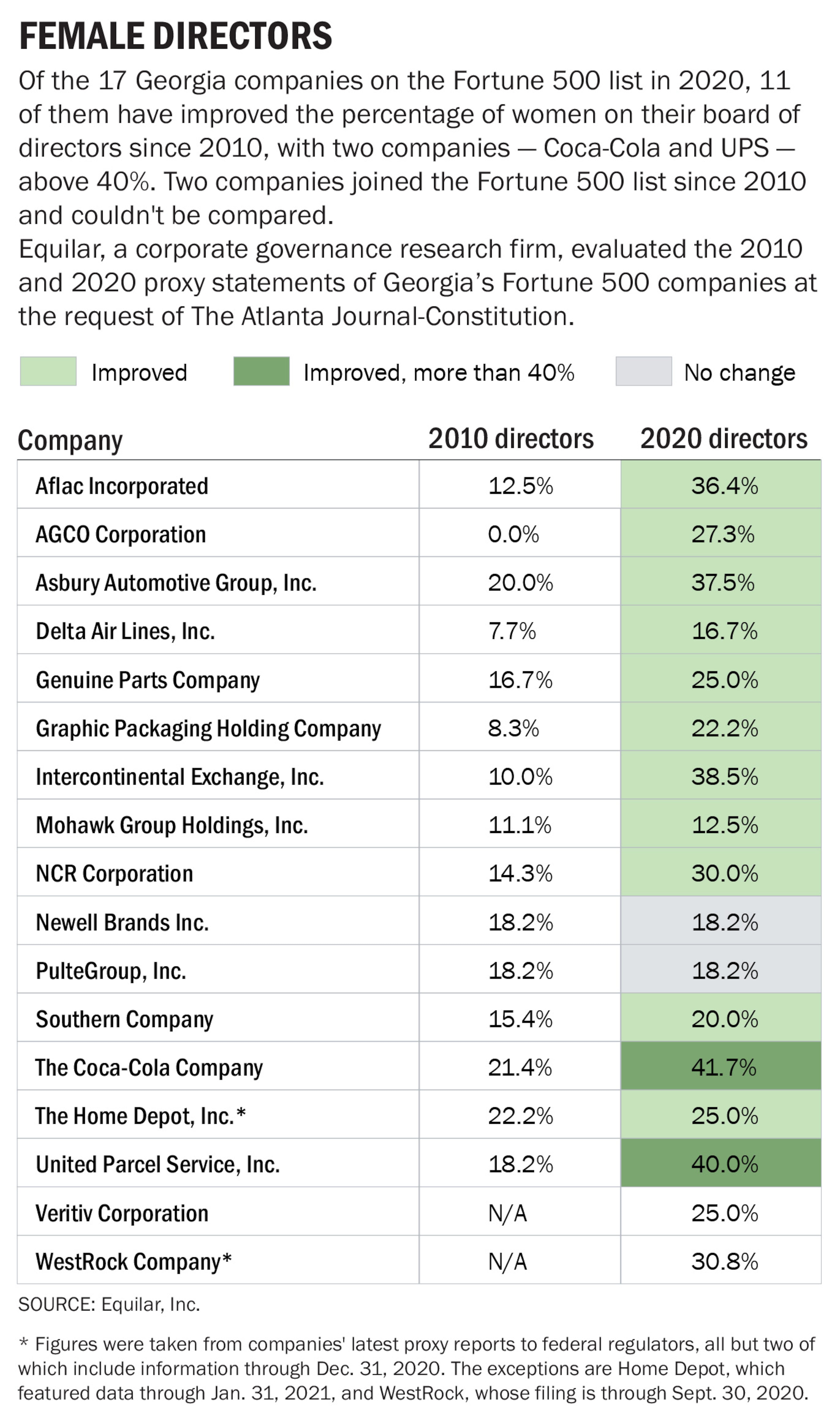
Some industries traditionally have skewed more than others toward men, an imbalance that several large Georgia companies have sought to remedy.
Executives at Veritiv, an Atlanta packaging and distribution company, have gotten creative in recent years to help diversify company warehouses, which are currently about 90% male. Leaders have reshuffled the work tasks for some jobs to lower some of the lifting requirements, an area that had been a barrier in the past, according to Dean Adelman, the company’s chief human resources officer.
“We’re trying to move some of those requirements around so we can really open it up to more women in our hourly workforce,” said Adelman. He added that company executives spend a day each month focused on talent development, diversity and equity.
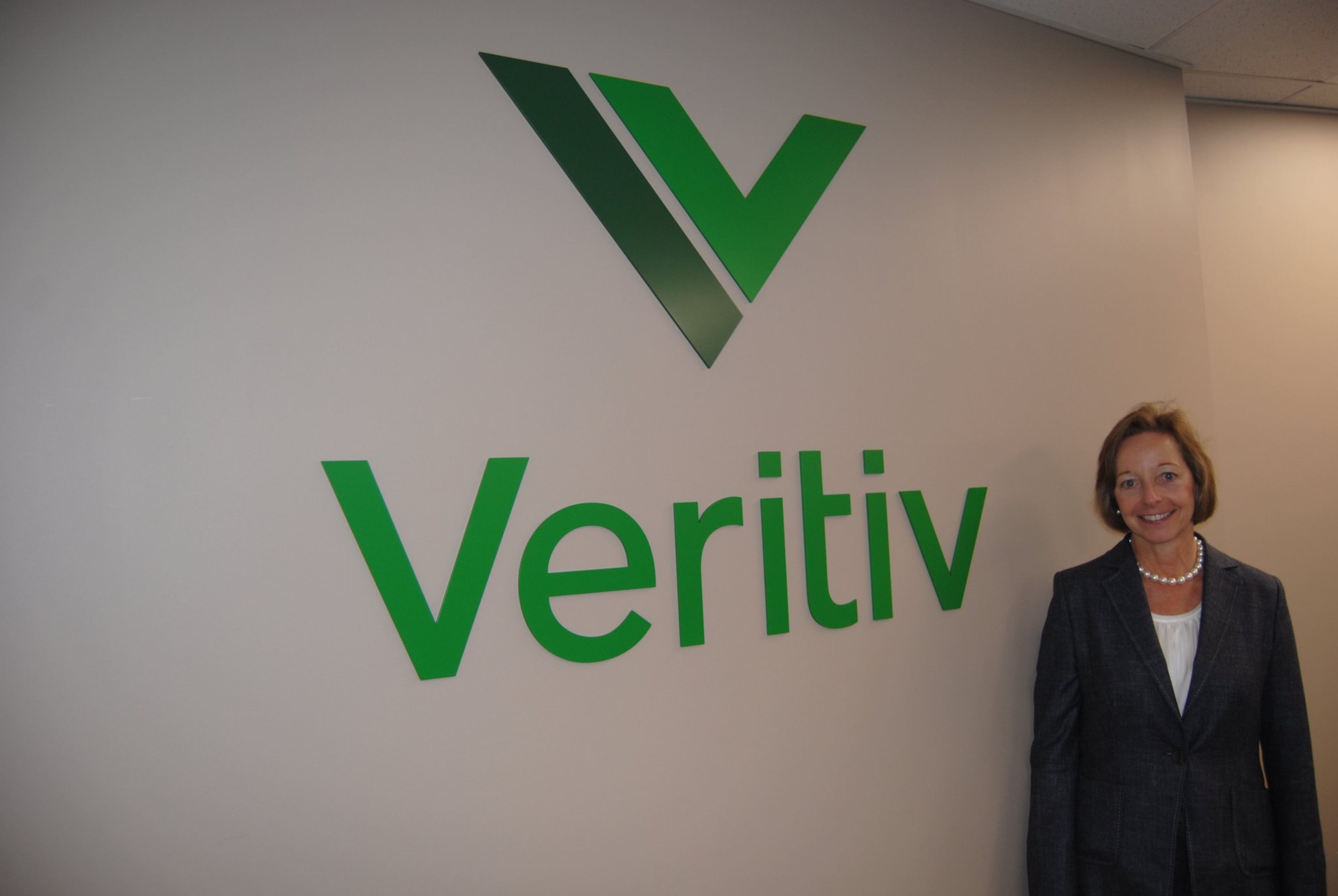
Changing course
A question many policymakers have grappled with in recent years is whether companies can achieve gender parity on their own.
Norway has for years had gender quotas for board members, and in 2018 California became the first U.S. state to mandate that companies based there have at least one female director or face a $100,000 fine.
Pressure also has come from investor groups that track environmental, social and governance metrics, including the gender and racial diversity of company leaders. Some big groups, including BlackRock and State Street Global Advisors, have threatened to withhold votes for directors at companies that they believe don’t adequately emphasize such factors.
Some directives have prompted pushback. California’s statute has drawn lawsuits from critics who believe the mandate violates the Constitution’s equal protection clause. And Senate Republicans panned a recent proposal from Nasdaq requiring companies on its stock exchange to appoint at least one woman and one racial minority or LGBTQ member to their boards or explain why they can’t.
“We commend individual firms for the proactive efforts they have already made in recruiting, promoting, and maintaining diverse talent,” the 12 GOP members of the Senate Banking Committee wrote in a February letter. “However, it is not the role of Nasdaq … to act as an arbitrator of social policy or force a prescriptive one-size-fits-all solution upon markets and investors.”
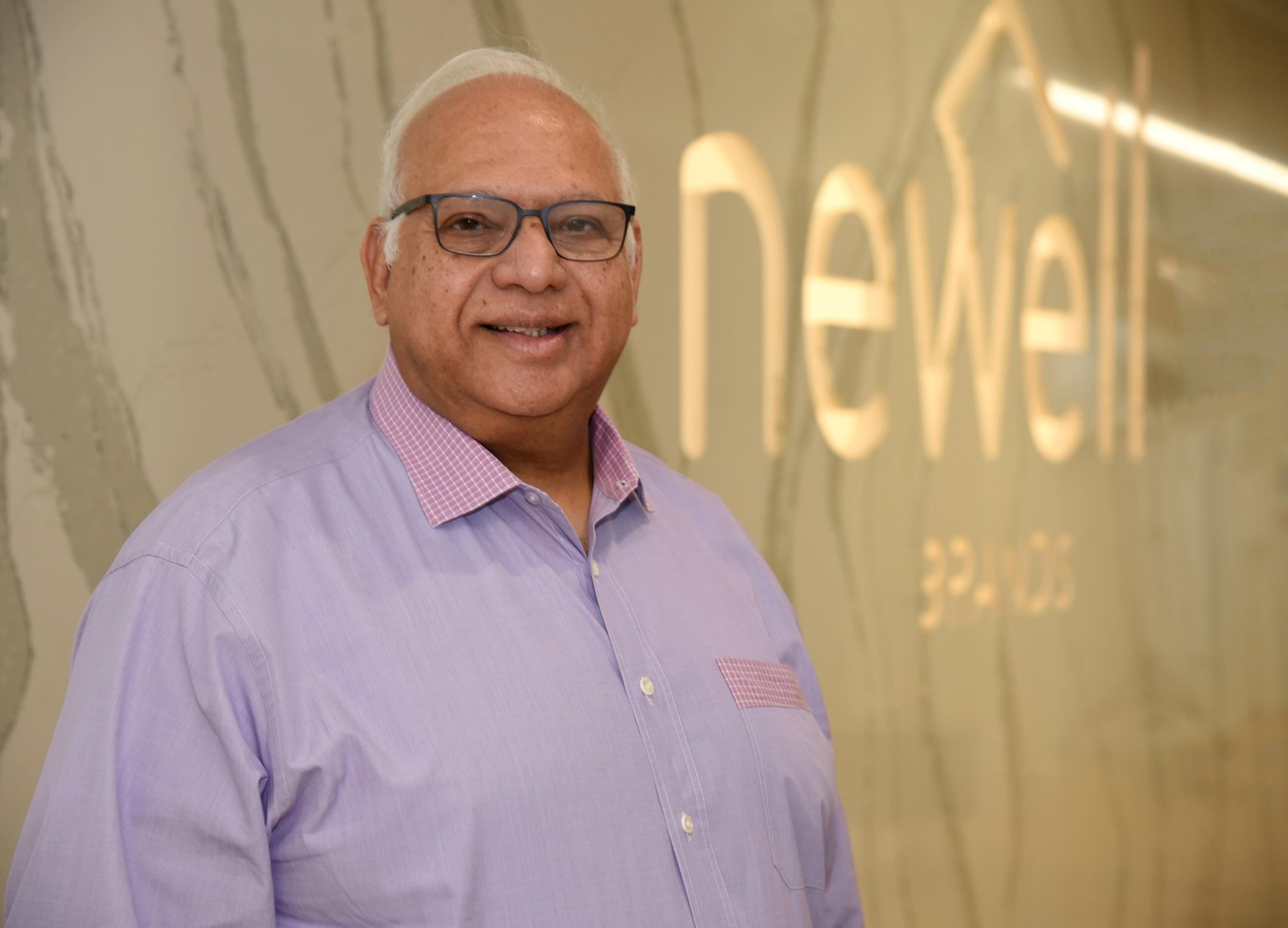
In the meantime, organizations like Bickford’s have emerged to help companies make changes on their own. Paradigm for Parity has a five-point action plan and toolkit for member companies, including unconscious bias training, sponsorship programs and targets for increasing women at every level of an organization. (Coca-Cola is a member, as is Salesforce, which has a major branch in Atlanta.)
Locally, the company that’s come the closest to gender parity is the consumer products firm Newell Brands, which reported last year that two of its five named executive officers were women. In a recent interview, CEO Ravi Saligram listed actions the company has taken to promote gender diversity, from instituting a review system for pay inequities to setting hiring goals for its leadership teams and requiring recruiters to include a diverse slate of candidates for each job posting.
“These are all things that we’re trying to do to foster a culture, because representation is only one indication,” said Saligram. “The key is ... how do you grow the talent (so) they can fulfill their full potential and there are not glass barriers.”
Aflac now ties its executive pay to achieving certain environmental, social and governance targets, according to White, and requires diversity among job candidates like Newell. White said she’s also taken to mentoring women on her own and floated the idea of providing executive coaches to women attempting to navigate the corporate landscape since there’s “no one size fits all on this.”
“Building a culture is a process,” White said. “You can’t do it overnight for a press release or to receive an award. It’s something that is built over time.”
Equilar, a corporate governance research firm, evaluated the fiscal 2010 and 2020 proxy statements of Georgia’s Fortune 500 companies at the request of The Atlanta Journal-Constitution. Publicly traded companies are required to file those proxies to the federal Securities and Exchange Commission ahead of their annual shareholder meetings. The statements include information about executive compensation, board members up for approval and other issues before the company. Equilar’s data represents a snapshot of who was at a company on Dec. 31, 2010 and 2020, with the exceptions of WestRock and Home Depot, whose fiscal years end on Sept. 30 and Jan. 31, respectively. If someone left earlier in the fiscal year, that person is not counted in the numbers.
As of last month, there were 18 Georgia companies on the Fortune 500. When Equilar completed this analysis for the AJC this spring, the state had 17 corporations on the list, so Global Payments, a financial technology company that debuted at No. 394 in June, is not included. Similarly, Atlanta-based HD Supply, a Fortune 500 last year, was excluded from this analysis because it was acquired by Home Depot at the end of 2020. Veritiv and WestRock, two Georgia companies the AJC included in its 2020 analysis, did not exist in 2010.



